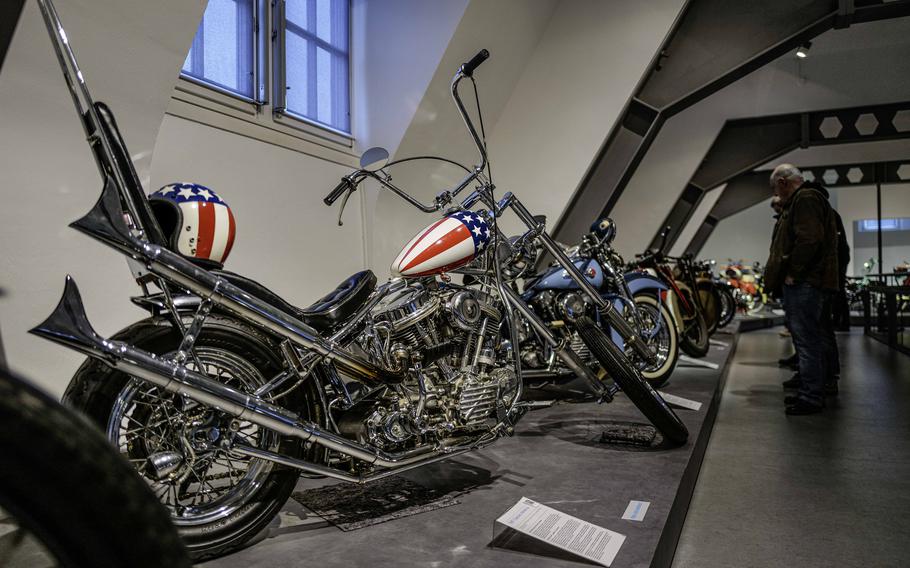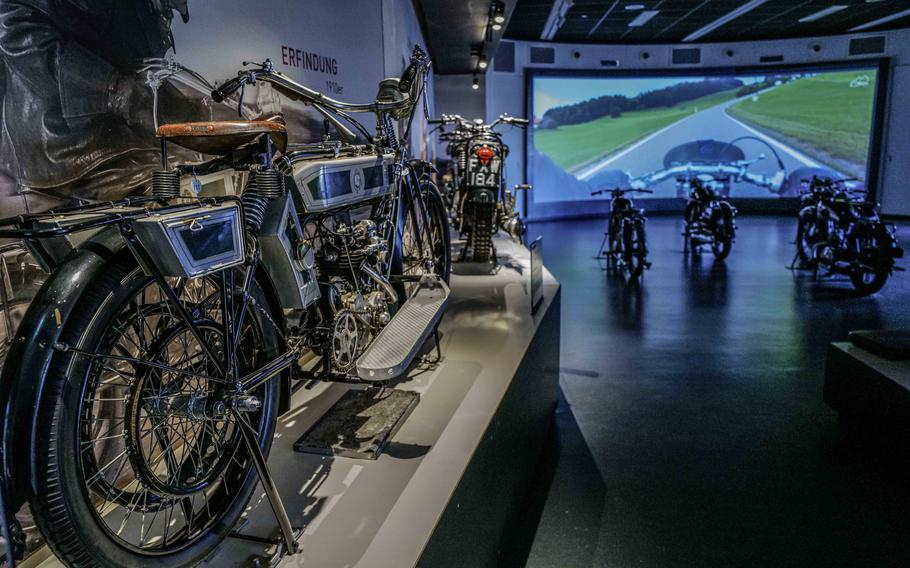
Visitors look at vintage Harley-Davidson models at the German Motorcycle Museum in Neckarsulm, Germany, Jan. 21, 2024. The museum also features this 1987 replica model with a Stars and Stripes tank design, paying homage to the custom chopper ridden by Peter Fonda in the iconic 1969 movie “Easy Rider.” (Alexander Riedel/Stars and Stripes)
From inner-city cobblestone streets to multilane highways, bicycles, motorcycles and scooters dominate European roads during the warm months.
Two-wheeled trips give me great enjoyment as well, but braving the outdoors on a vehicle exposed to the elements seems just a bit too daunting for me during this time of year in Germany.
Fortunately, there is an alternative for those dealing with the pangs of winter withdrawal: the German Motorcycle Museum in Neckarsulm. There’s more than just motorcycles, though.
While Neckarsulm isn’t a household name for Americans, this industrial suburb of Heilbronn was once as synonymous with German motorcycle craftsmanship as Milwaukee is with Harley-Davidson.
A former palace of the Teutonic Order, the museum has an exterior belying the modern marvels within. Entering it is like stepping into a bike fan’s dream, with shiny rides from floor to ceiling and stories to match each one.
From the pioneering designs of the early 20th century to the sleek, high-speed machines of today, the museum houses an impressive array of 140 motorcycle and bicycle brands, making it one of the largest collections in Germany.
The narrative begins with NSU, a local manufacturing legend closely tied to the city’s name, derived from the nearby Neckar and Sulm rivers.
The company originally manufactured knitting machines, but by the early 20th century, NSU had embraced the motorcycle, producing its first model in 1901. By the 1950s, the company boasted the largest production volume worldwide.
While swapping knitting needles for gears and pistons was a good business move, the company eventually merged with Audi, shifting its focus to automobiles.
The last NSU motorcycle rolled off the line in 1963, and fewer than 14,535 of them remain registered on German roads, according to the Federal Motor Transport Authority.
The museum allows visitors to immerse themselves by sitting on several vintage NSU motorcycles, equipped with spring-cushioned seats, while gripping the handlebars and watching a rider’s point of view on a large screen. This setup primes visitors for a deep dive into cycling history.

A 1910 NSU V-Twin, left, opens the video theater exhibit at the German Motorcycle Museum in Neckarsulm, Germany. The theater allows visitors to get up close with real vintage motorcycles, sitting on them while watching a point-of-view rider documentary video. (Alexander Riedel/Stars and Stripes)
From the very inception of two-wheeled travel marked by the 1817 Draisine, to Tour de France bikes and modern e-bikes, the museum covers a broad spectrum of pedal- and motor-driven cycles.
Visitors can even climb aboard a penny-farthing, the famous 19th-century bicycle with a comically oversized front wheel, securely mounted to the ground, offering a whimsical photo opportunity.
However, it was the 1885 Daimler riding wagon, a wood-framed precursor to modern motorcycles, that captured my imagination the most.
Before manufacturing luxury limousines, Gottlieb Daimler and Wilhelm Maybach experimented with attaching a single-cylinder, four-stroke engine to a wooden cart.
This rudimentary vehicle, complete with support wheels, forms a direct link to the origins of motorized transport.
Also showcased is the first mass-produced model, the 1894 Hildebrand & Wolfmueller, which necessitated its own chassis design to accommodate the weight of its two-cylinder engine, making it the first to be officially called a “motorcycle.”
It also pioneered the use of pneumatic tires, literally putting rubber to the road.
The museum pays homage to American motorcycles, too, featuring a 1917 Harley-Davidson J Model in olive green — a nod to the U.S.’ entry into World War I — and a pristine 1929 Indian Scout 101, showcasing the craftsmanship and style of early American bikes.
A 1935 Indian Four, on the other hand, likely never saw an American highway, given that it was exported to Berlin as one of the last Indian motorcycles to reach the country before Nazi import duties made it practically impossible to get an American-made bike into Germany.
What struck me was the museum’s capacity to showcase the breadth of motorcycle history without feeling cluttered. Starting with 70 exhibits in the 1950s, it now spans over 21,528 square feet, making it Germany’s largest museum of its kind.
QR codes for non-German speakers bridge the language gap effectively, allowing visitors to unlock the stories behind the exhibits.
Beyond the rubber and steel on display, the exhibits’ narratives extend to the stories of exploration that capture the essence of motorcycle travel.
Sagas of adventurers like photographer Eitel Lange, who circumnavigated the globe on a Zundapp KS 601 and sidecar complete with travel-worn stickers, or journalist Guenter Markert’s around-the-world journey on a humble R50 scooter, encapsulate the true spirit of the open road on two wheels.
In exploring the museum, I was reminded of the universal appeal of motorcycles in just such tales.
For bike enthusiasts, a visit is not only educational but also sure to be a source of inspiration for the next spring adventure once the winter chill is in the rear-view mirror.
On the QT
Address: Urbanstrasse 9-11, Neckarsulm, Germany
Hours: Year-round, 10 a.m.-5 p.m. Tuesday through Sunday; closed Mondays, Christmas and New Year’s Eve.
Cost: Entry is 7.50 euros per adult; motorcyclists carrying a helmet pay 6 euros; entry is free for children under 6.
Information: Online: demomu.de